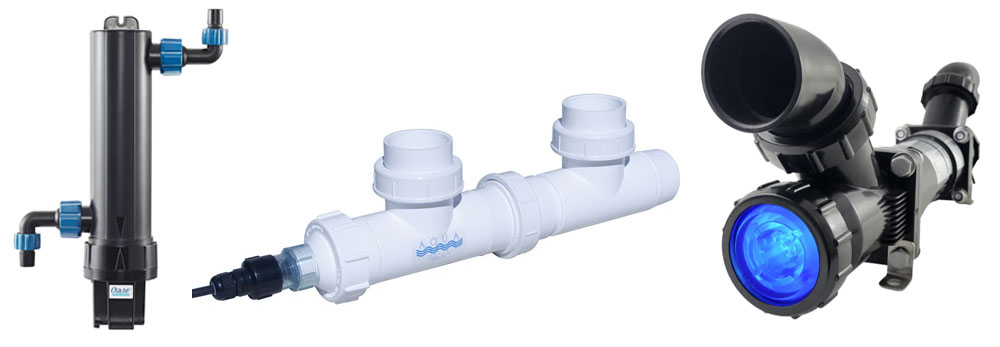Aquarium UV Sterilizer Overview

Note: If you already have a UV Sterilizer and you're trying to figure our why it isn't working, please read the UV Sterilizer Troubleshooting Guide
What is UV Sterilization? It's a very simple process using ultraviolet (UV) light for rendering sterile unwanted free-floating bacteria, algae, and parasitic organisms, like ich. The UV sterilizer light affects living cells by altering the structure of the cell's nuclear material. The end result is the organisms fail to reproduce, eradicating your aquarium or pond water of these unwanted nuisances.
Functionally, UV sterilization is done by running water in and out of a chamber that contains a UV sterilizer light bulb. The UV sterilizer bulb is usually contained in a glass (quartz) sleeve that is in the shape of a test tube.
How are they set up? There are THREE types of UV sterilizer set-ups, the
in-line , the
in-tank (or
in-pond) and the
hang-on types (
some sterilizers can be hooked up as a hang-on or an in-tank sterilizer). The in-line set-up usually has the sterilizer under the tank (or beside a pond) in line with a pump and filter (if a mechanical filter is used). For most ponds and tanks above 100 gallons you will need to get an
in-line UV sterilizer.
Hang-on UV sterilizers have a mechanism for hanging the UV off the back of an aquarium. This is often easier to set up, but hobbyists often prefer the in-line set-up because it removes the somewhat unsightly piece of equipment from view. You could also hang a hang-on UV on a sump.
A sub-category of the in-line sterilizers is the filter outlet UV category. We carry the
Fluval In-Line,
Fluval FX Clarifier, and the
OASE Cleartronic UV.
UV sterilizers require a pump with a certain flow rate to run water through them. It is critical that the pump put out a flow rate within the acceptable range of the UV sterilizer. These acceptable flow rates are listed next to all the UVs we sell in terms of gph (gallons of flow per hour). The flow rate depends on whether you are using the UV in a pond or aquarium and if you are using the UV to sterilize bacteria or clarify the water (
sterilize the algae). In the case of hang-on UV sterilizers, we've also recommended pumps to use with the UV.
How about UV sterilizer safety?UV sterilizer light can be damaging to the human eye so
DO NOT look into the bulb. Always unplug your unit when working on it to prevent possible shock if it breaks and gets wet.
Who needs a UV sterilizer?UV Sterilizers are recommended for all saltwater and freshwater aquariums, and ponds.
What can be eliminated with a UV sterilizer?
- UV sterilizers will eliminate protozoan parasites such as ich during the newborn, free swimming life cycle stage of the parasites. NOTE: They do not eliminate the ich parasites once attached to the fish. UV sterilizers can be used with other methods to treat ich.
- UV sterilizers will sterilize free-floating algae. It will not sterilize algae that is stuck to your glass or embedded in your live rock. The algae needs to go through the UV sterilizer to be sterilized.
Can UV Sterilizers have negative effects?Yes. UV can alter the structure of some dissolved chemical compounds. When using any drug or chemical medication check the directions for the drug or chemical to see if you should turn off your UV when using the drug or medication.
Many aquarists only use a UV sterilizer during the day. There are many free-floating beneficial planktonic animals in the water that come out at night that can be killed by a UV sterilizer. You can put your UV on the same timer as your lighting system.
UV Sterilizer MaintenanceUV sterilizer bulbs with four pins at one end should be replaced once a year. Lamps with two pins at each end should be replaced every six months. They will lose intensity over time, and after these respective periods of time, the loss in intensity is likely to be critical.
Depending on how clean the water is going into the UV sterilizer, you may need to clean your UV sterilizer quartz sleeve. If the UV light from the bulb can't penetrate the sleeve, then it won't reach the water that flows around the quartz sleeve. The quartz sleeve can be cleaned with white vinegar.
Flow RatesThe recommended flow rates and required wattage for tanks may not seem consistent between manufacturers. The Aqua Ultraviolet 25-Watt UV Sterilizer is rated for tanks up to 100 gallons. The Coralife 18 Watt is rated for 250 gallons. Some of this may be because the manufacturers are measuring things differently. The recommended flow rates are sometimes based on when UV sterilizer lamps are operating at their 60% end-of-life efficiency. Additionally, flow rates may be comparing apples and oranges because they may be referring to the effective kill rates of different organisms.
We find the tank and pond ratings from Lifegard Aquatics and Aqua Ultraviolet to be consistent with each other and to be reasonable.




























